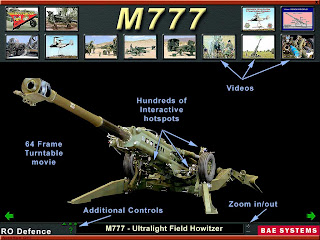.jpg)
.jpg)
Since India is trying to maximize the use of its defence budget before the end of this fiscal year, The Indian Army will soon acquire 145 ultra-light howitzers from the US. The Indian Defence Acquisitions Committee (DAC) has taken a decision to pursue the foreign military sales (FMS) route and the deal is expected to be to the tune of $647 million.
.jpg)
As for the US Pentagon, the possible sale of 145 state-of-the-art lightweight towed Howitzers to India has been notified to the US Congress. For the US, this proposed sale will contribute to the foreign policy and enhance the US-India strategic relationship. India intends to use the howitzers to modernise its armed forces and enhance its ability to operate in hazardous conditions.
The Indian Army will get the M777 145 ultra-light howitzers, whose main contractors will be US-based BAE of Hattiesburg and Mississippi. This procurement will be part of the first phase of the field artillery rationalisation plan. This plan is part of the programme to upgrade Indian Army’s artillery divisions. The Indian Army aims to buy 145 ultra-light howitzers, 158 towed and wheeled, 100 tracked, and 180 wheeled and armoured guns as a part of this entire phase of the plan.

According to BAE officials, M777 is, by some considerable margin, the lightest 155 mm howitzer in the world and the only system proven in battle. The M777 meets the requirement for the Indian Army’s Ultra Lightweight howitzer programme and the only one in full production. A significant amount of work share would be completed in India by the Mahindra and BAE Systems joint venture Company, officials added.
In the beginning, there was another ultra-light howitzer in competition for the Indian Army’s artillery modernisation programme which was the ‘Pegasus’ by Singapore-based ST Kinetics. Since ST Kinetics was blacklisted last year, the DAC decided to go the FMS route which is a US programme of government-to-government sales of military hardware, avoiding delays of competitive bidding.
- M 777 Key Data
Crew - Normally 7 (can be a reduced detatchment of 5)
Overall Length, Towing Mode -9,275mm
Overall Length, Firing Mode - 10,210mm
Overall Width, Towing Mode.jpg) - 2,770mm
- 2,770mm
Overall Width, Firing Mode - 3,720mm
Overall Height, Towing Mode - 2,260mm
Trunnion Height, Firing - 650mm
Operational testing with the USMC, during which nearly 12,000 artillery rounds were fired by four production systems, was completed in December 2004. A contract for full-rate production of 495 systems was awarded to BAE Systems in April 2005. In May 2005, the USMC began fielding the M777 with the 11th Marines unit at Twentynine Palms in California..jpg)
The first 18 systems were delivered to the US Army's 2nd Battalion, 11th Field Artillery in Hawaii in October 2006.
The M777 will be the artillery system for the Stryker Brigade Combat Teams (SBCT). The systems fitted with the digital fire control system are designated M777A1, and those with the software update which allows the firing of the Excalibur projectile, M777A2. M777A2 received full material release in July 2007, clearing the upgrade for fielding. All M777A1 systems will be upgraded to the A2 standard.
The M777 was deployed by the US Army and Marine Corps to Afghanistan in December 2007 and to Iraq in 2008.
The Excalibur projectile was first deployed in Afghanistan in March 2008.
By August 2008, over 400 systems had been delivered to the US Army and USMC.
In April 2008, BAE Systems received an order for an additional 87 M777 systems for the US Army and USMC. Deliveries are scheduled from 2010. In August 2008, a further 43 systems were ordered.
In December 2005, the first four of six M777 systems were supplied by the USMC to the Canadian Army, under a foreign military sales (FMS) contract. The systems were deployed to Afghanistan in February 2006. A further six systems have been ordered and are in service. In June 2008, Canada requested a further 25 systems, a total of 37. .jpg)
In July 2008, Australia requested the foreign military sale of 57 M77 howitzers.
BAE Systems has developed a mobile version, the M777 Portee, which is mounted on a purpose-built 8x6 Supacat vehicle. The vehicle was first shown at Eurosatory in June 2006.
"The construction of the M777 makes extensive use of titanium and titanium castings."
The M777 has been developed by BAE Systems Land Systems (RO Defence, formerly the Armaments Group of Vickers Shipbuilding and Engineering Ltd) at Barrow-in-Furness. United Defense LP of Pascagoula, Mississippi is responsible for final assembly, test and delivery of production systems for the US.
In July 2004, the M777 successfully completed a series of airlift tests with the US Marine Corps MV-22 Osprey tiltrotor aircraft. The M777 was carried as an external load for a distance of 69nm.
The M777 is normally operated by a crew of eight men but can be operated with a reduced detachment of five.
Design
The construction of the M777 makes extensive use of titanium and titanium castings, enabling a weight reduction of 3,175kg (7,000lb) compared to the M198 howitzer which it replaces in the US Army and USMC inventory. The titanium is supplied by RTI International metals of Niles, Ohio.
Armament
The M777 matches the firepower of current generation 155mm towed systems at less than half the weight. The Howitzer is equipped with a 39-calibre barrel. The muzzle velocity (at Charge 8 super) is 827m/s.
The maximum firing range is 24.7km with unassisted rounds and 30km with rocket-assisted rounds. The M777A2 will fire the Raytheon / Bofors XM982 Excalibur GPS / Inertial Navigation-guided extended-range 155mm projectiles using the Modular Artillery Charge Systems (MACS). Excalibur has a maximum range of 40km and accuracy of 10m.
First firing trials of the M777A1 with Excalibur took place in August 2003. First production rounds were delivered in September 2006. Excalibur successfully completed limited user test in March 2007. It was first fielded in Iraq in May 2007 and in Afghanistan in February 2008.
The M777 is able to deliver up to five rounds a minute under intense firing conditions and is able to provide a sustained rate of fire of two rounds a minute.
Fire control
The LRIP systems employ an optical sighting system for direct and indirect firing by day or night. Full production systems will be fitted with the General Dynamics Armament Systems Towed Artillery Digitisation (TAD) system. LRIP systems will be retrofitted with TAD..jpg)
"The M777 is able to deliver up to five rounds a minute."
The TAD digital fire control system provides onboard ballistic computation, navigation, pointing and self-location, providing greater accuracy and faster reaction times. The TAD system also includes a laser ignition system, electric drives for the howitzer's traverse and elevation and a powered projectile rammer.
Mobility
The M777 has a production weight of 3,745kg and can be transported by helicopter, transporter aircraft and ship. The howitzer can be towed by an air-braked 4x4 vehicle greater than 2.5t.
The hydrostrut suspension system is provided by Horstman Defence Systems of the UK. The maximum towed road speed is 88km per hour and the towed cross-country speed is 50km per hour. The load on the towing eye is rated at 60kg. The towing ground clearance is up to 660mm.
Sidharth K Menon
